Knobby Knees

|
Knobby Knees: aka The Maha Myat Muni Buddha
Image 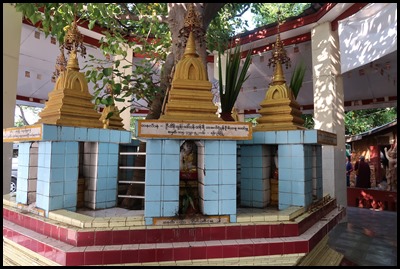 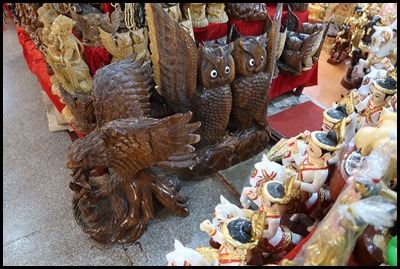 Our first stop of the day was a very special one, to see the
most revered Buddha image in the area. We left our shoes in the car and bimbled
past a shrine in somewhat poorly condition. The we
entered a ‘tunnel’ with shops tightly packed in on
both sides.  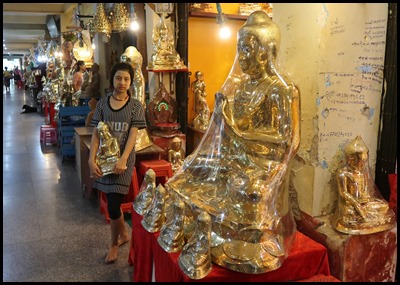 So many shops with so many statuettes, some huge.
One lass had a wilting stare as she surveyed all she
had to polish.   At the end of the corridor we turned left, even more shops and
we could see a huge TV screen at the end. The main room of the pagoda was vast, very
ornate ceiling but the TV screens on pillars each side of the view to
Buddha now looked quite out of
place   The chapel had many ladies in prayer, the screen showed men
tending to Buddha. Ladies are not allowed to go through the airport style
scanner and beyond into Buddha’s room. Off Bear went with the camera. A Myanmar
website says: The Maha Myat Muni Pagoda (also
known as the Phaya Gyi), the most ancient Buddha image in Myanmar. He was cast
in the life-span of Lord Buddha in the seated posture of relaxed deportment,
namely Bumi Phasa Mudras, symbolic of His Conquest of Mara.
The 4m high-seated image is cast in bronze and weigh 6.5 tons, his crown is decorated with diamonds, rubies and sapphires. Maha Myat Muni Buddha Image was being cast in front of the Buddha himself it can say Maha Myat Muni Buddha Image is the portrait of Buddha and the face is most revered. Every morning at 4:30 am, a team of monks washes the face and brushes the teeth. Since Myanmar Buddhists are so devout countless thousands of devotees apply gold leaf to gain merit, the image has completely covered with 15 cm thick gold and original shape is very distorted. Hence I named him Knobby Knees because they are, wonder what he will look like in another hundred years......
Bear was allowed into the ante-room, only those men applying gold leaf can go all the way to the Buddha
Image.  On another site I found a lovely passage that reads: In B.C 123, in the reign of King Sanda Thuriya, Monarch of Rakhine-Dharyawaddy, and carry the Image reverently so as to enshrine it at the present site. It took four months to carry the image reverently across the Rakhine Yoma Ranges, by inland route and by waterway a tough and rough journey indeed. The Height of the Maha Muni Buddha Image is 8 Cubits and 1 Maik (3.83 m). The altar is 2.13 m high. There, 2 bronze Siamese images, 3 bronze lion images and 1 bronze three headed Ayeyawun elephants are housed and displayed in the precinct on the left side of the northern exit passage. Whoever visits Mandalay from local areas or from abroad unfailingly come and pay homage to the Maha Muni Buddha Image. King Bodawpaya built this Pagoda in 1784 to house the Maha Myat Muni Buddha Image brought from Rakhine State. Being the most revered Pagoda in Mandalay, the early morning ritual of washing the face of the Buddha's image, draws a daily crowd of devotees. Apparently, people take their own towels with them (not sure if a group is chosen beforehand or many hopefuls turn up and get randomly selected). The washing ceremony takes a good hour with the chief monk face washing and taking special care with the teeth, Buddha’s face is then rinsed again and the devotees towels are used to dry every inch of the shiny face. The towels then go home and are draped around the household shrine and are held in very high regard.
 
Outside, we took in the pagoda itself. Major restoration is going on above Buddha. To the right, many ‘little pagodas’ make up the ornate edging to the roof.
  
A local lady, one of the many stupas and Bear found a sad looking bell.
   Passing a tower, we cut through the
first lot of shops and saw away to our left what we
thought would be a museum.
 Up the very ornate
stairs.............
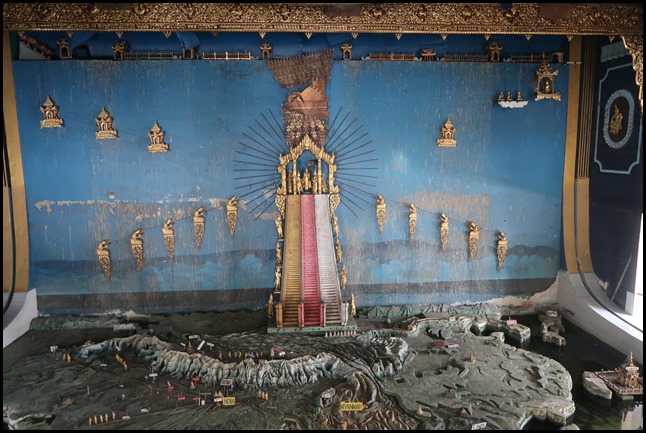  ........through the doors and wow. We were looking down on a
vast map showing the major holy
sites.
 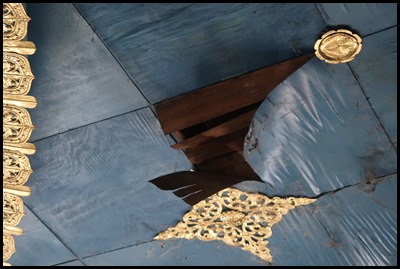 Part of the ceiling was sumptuous,
part needed urgent TLC.
 To our left, many
cases with artifacts and special pictures.
  To our right photographs with corresponding paintings, the
first – Lumbini, the birthplace
of Buddha, we hope to visit next April.
  Bodh Gaya, the enlightenment of Buddha.
   Back through the well-tended
gardens, the gamut of shops and onward in the
car to our next stop, Mingun.
ALL IN ALL QUITE AN EXPERIENCE
AN UNUSUAL SHAPED
FELLOW |


